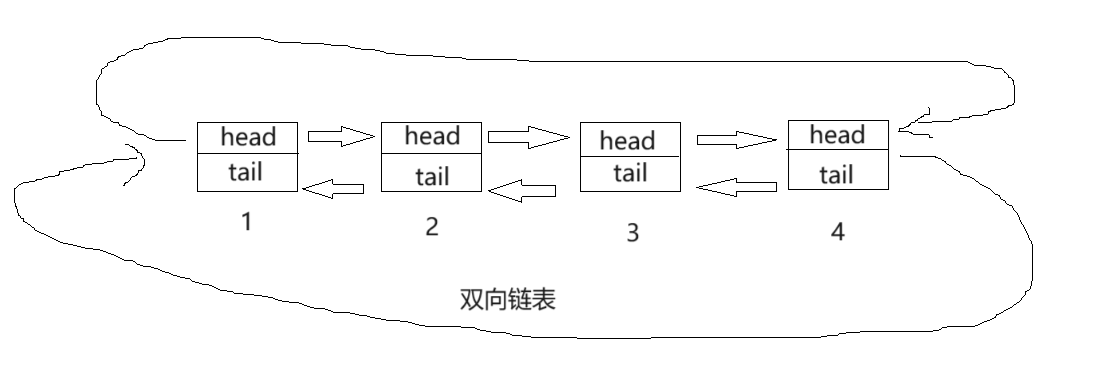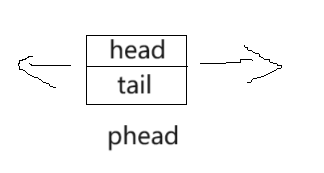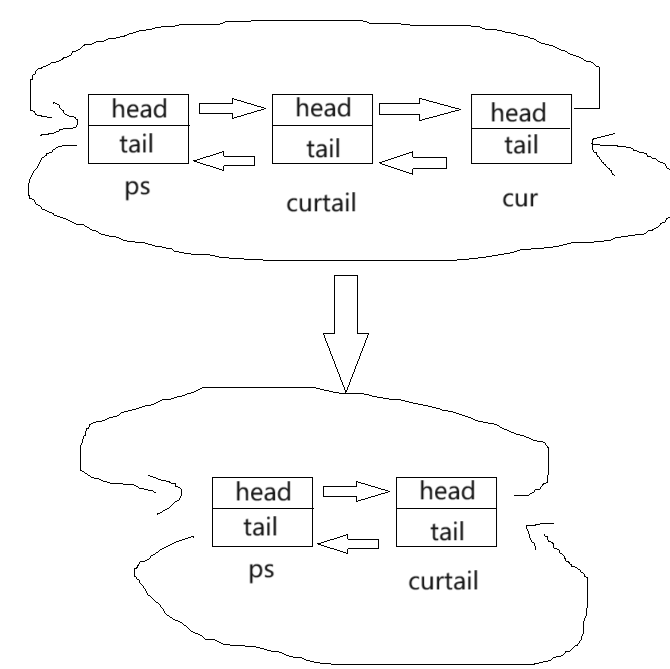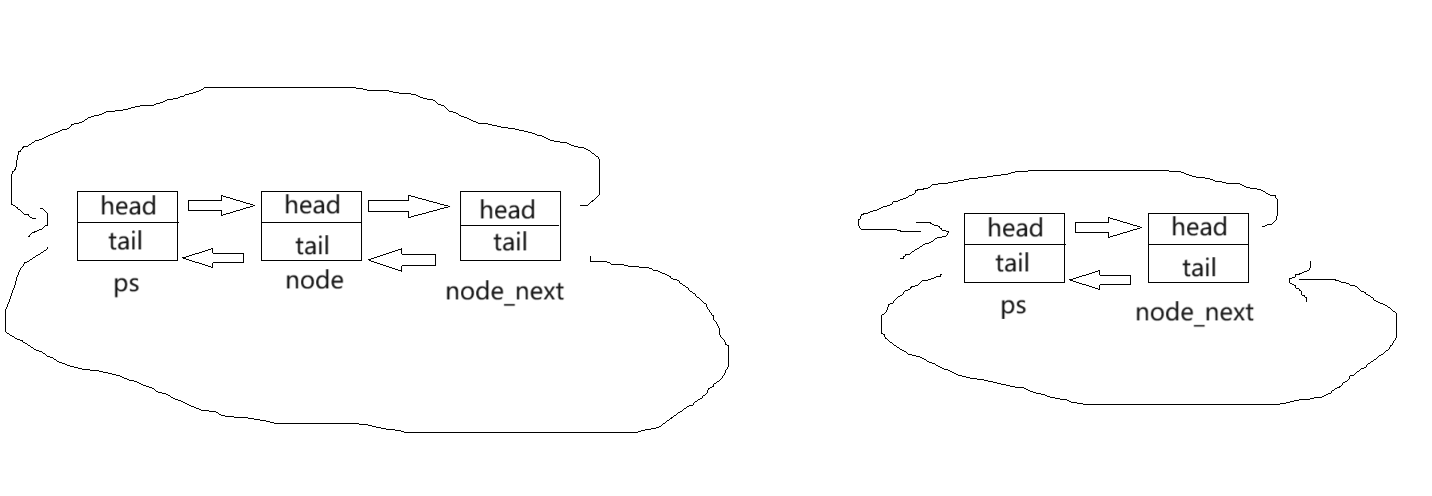双向链表(数据结构与算法)

????????????????
????????????????
🌿🌿🌿🌿🌿🌿🌿🌿🌿🌿🌿🌿🌿🌿🌿🌿
🌟🌟🌟🌟🌟🌟🌟🌟🌟🌟🌟🌟🌟🌟🌟🌟
🌟🌟 追风赶月莫停留 🌟🌟
🍀🍀🍀🍀🍀🍀🍀🍀🍀🍀🍀🍀🍀🍀🍀🍀
🌟🌟 平芜尽处是春山🌟🌟
🌟🌟🌟🌟🌟🌟🌟🌟🌟🌟🌟🌟🌟🌟🌟🌟
🌿🌿🌿🌿🌿🌿🌿🌿🌿🌿🌿🌿🌿🌿🌿🌿
????????????????
????????????????
🍋双向链表
🍌双向链表的定义与结构

双向链表:双向链表也叫双链表,是链表的一种,它的每个数据结点中都有两个指针,分别指向直接后继和直接前驱。所以,从双向链表中的任意一个结点开始,都可以很方便地访问它的前驱结点和后继结点。一般我们都构造双向循环链表。(两个指针就是一个指向下一个数据,另一个指针指向上一个数据。如图中head头指针和tail尾指针)

在双向链表中还有一个特殊点,就是头指针,双向链表是带头的。在上次我们说的单链表中是不带头的,一旦涉及到头,我们就是先判断是不是为空,而在双向链表中就是不会涉及到这个问题了,不用再去一个一个的判断,就会省去很多的麻烦。
带头的双向链表嘴尾常用,所以我们这里就介绍带头的双向链表
🍌双向链表增删查改(有头+双向+循环链表增删查改实现)
🍍其它接口
#include<stdio.h>
#include<assert.h>
#include<stdlib.h>
typedef int LTdatetype;
typedef struct ListNode
{
LTdatetype date;
struct ListNode* next;
struct ListNode* tail;
}ListNode;
定义一些接口
🍍创建返回链表的头结点
//创建返回链表的头结点
ListNode* Create(LTdatetype x)
{
ListNode* cur =(ListNode*)malloc(sizeof(ListNode));
if (cur == NULL)
{
perror("malloc faild");
exit(-1);
}
cur->next = NULL;
cur->tail = NULL;
cur->date = x;
return cur;
}
ListNode* Inia()
{
ListNode* node = Create(0);
node->next = node;
node->tail = node;
return node;
}
Create函数就是创建一个节点。而Inia函数本来是进行初始化,而想要变成循环的链表,形参改变实参那就要用到二级指针,因为这里是双向链表,涉及头指针的时候不需要考虑二级指针,所以在这里就只有初始化需要用到头指针,所以我们就干脆用返回值,这样就不看起来违和了,当然用二级指针也没有什么问题,看自己习惯即可。
🍍双向链表销毁
// 双向链表销毁
void Destreoy(ListNode* ps)
{
assert(ps);
ListNode* cur = ps->next;
while (cur != ps)
{
cur = cur->next;
free(cur->tail);
}
free(ps);
}
🍍双向链表打印
// 双向链表打印
void Print(ListNode* ps)
{
assert(ps);
ListNode* cur = ps->next;
while (cur != ps)
{
printf("%d<=>", cur->date);
cur = cur->next;
}
}

在这里打印,我们就不能使用和单链表打印的方法了,因为我们这里是循环链表,并且我们的ps里面没有存有数据,所以我们要从ps的下个数据开始,也就是图中cur的位置,然后在cur到ps的时候跳出循环就可以了。
🍍双向链表尾插
// 双向链表尾插
void LTpushbake(ListNode* ps, LTdatetype x)
{
assert(ps);
ListNode* cur = Create(x);
ListNode *node = ps->tail ;
//ps的头要指向cur
node->next = cur;
//cur的尾要指向ps
cur->tail = node;
//ps的尾要指向cur
ps->tail = cur;
//cur的头要指向ps
cur->next = ps;
}

之所以要这样的指向,是因为这是一个循环的双向链表。
🍍双向链表尾删
// 双向链表尾删
void LTpopbake(ListNode* ps)
{
assert(ps);
assert(ps->next != ps);
ListNode* cur = ps->tail;
ListNode* curtail = cur->tail;
free(cur);
cur->next = cur->tail = NULL;
curtail->next = ps;
ps->tail = curtail;
}

在这里因为这是循环链表所以不用遍历去找尾结点,当然用遍历也是可以的
🍍双向链表头插
// 双向链表头插
void LTpushfront(ListNode* ps, LTdatetype x)
{
assert(ps);
ListNode* node = Create(x);
ListNode* cur = ps->next;
ps->next = node;
node->tail = ps;
node->next = cur;
cur->tail = node;
}

在带头的链表中,头插是最方便的,不用像不带头的单链表中一个一个去判断,大大的节省了我们的时间
🍍双向链表头删
// 双向链表头删
void LTpopfront(ListNode* ps)
{
assert(ps);
assert(ps->next != ps);
ListNode* node = ps->next;
ListNode* node_next = node->next;
free(node);
ps->next = node_next;
node_next->tail = ps;
}

在带头的链表中,头删也很方便了。
🍍双向链表查找
// 双向链表查找
ListNode * LTfind(ListNode* ps, LTdatetype x)
{
assert(ps);
ListNode* cur = ps->next;
while (cur != ps)
{
if (cur->date == x)
{
return cur;
}
cur = cur->next;
}
return NULL;
}
关于这个查找还是要注意下,因为我们这里是循环链表,所以要注意记得要设置跳出循环的条件。
🍍双向链表在pos的前面进行插入
// 双向链表在pos的前面进行插入
void LTinsert(ListNode *pos, LTdatetype x)
{
assert(pos);
ListNode* node = Create(x);
ListNode* pos_tail = pos->tail;
pos_tail->next = node;
node->tail = pos_tail;
node->next = pos;
pos->tail = node;
}

在pos前插入和头插,尾插差不多的意思
🍍双向链表删除pos位置的节点
// 双向链表删除pos位置的节点
void LTdelete(ListNode* pos)
{
assert(pos);
ListNode* pos_tail = pos->tail;
ListNode* pos_next = pos->next;
free(pos);
pos_tail->next = pos_next;
pos_next->tail = pos_tail;
}

删除pos位置,也差不多和前面意思都差不多
🍌双向链表整体代码的实现
#include<stdio.h>
#include<assert.h>
#include<stdlib.h>
typedef int LTdatetype;
//创建返回链表的头结点
typedef struct ListNode
{
LTdatetype date;
struct ListNode* next;
struct ListNode* tail;
}ListNode;
ListNode* Create(LTdatetype x)
{
ListNode* cur = (ListNode*)malloc(sizeof(ListNode));
if (cur == NULL)
{
perror("malloc faild");
exit(-1);
}
cur->next = NULL;
cur->tail = NULL;
cur->date = x;
return cur;
}
ListNode* Inia()
{
ListNode* node = Create(0);
node->next = node;
node->tail = node;
return node;
}
// 双向链表销毁
void Destreoy(ListNode* ps)
{
assert(ps);
ListNode* cur = ps->next;
while (cur != ps)
{
cur = cur->next;
free(cur->tail);
}
free(ps);
}
// 双向链表打印
void LTprint(ListNode* ps)
{
assert(ps);
ListNode* cur = ps->next;
printf("ps<=>");
while (cur != ps)
{
printf("%d<=>", cur->date);
cur = cur->next;
}
printf("\n");
}
// 双向链表尾插
void LTpushbake(ListNode* ps, LTdatetype x)
{
assert(ps);
ListNode* cur = Create(x);
ListNode* node = ps->tail;
node->next = cur;
cur->tail = node;
ps->tail = cur;
cur->next = ps;
}
// 双向链表尾删
void LTpopbake(ListNode* ps)
{
assert(ps);
assert(ps->next != ps);
ListNode* cur = ps->tail;
ListNode* curtail = cur->tail;
free(cur);
curtail->next = ps;
ps->tail = curtail;
}
// 双向链表头插
void LTpushfront(ListNode* ps, LTdatetype x)
{
assert(ps);
ListNode* node = Create(x);
ListNode* cur = ps->next;
ps->next = node;
node->tail = ps;
node->next = cur;
cur->tail = node;
}
// 双向链表头删
void LTpopfront(ListNode* ps)
{
assert(ps);
assert(ps->next != ps);
ListNode* node = ps->next;
ListNode* node_next = node->next;
free(node);
ps->next = node_next;
node_next->tail = ps;
}
// 双向链表查找
ListNode * LTfind(ListNode* ps, LTdatetype x)
{
assert(ps);
ListNode* cur = ps->next;
while (cur != ps)
{
if (cur->date == x)
{
return cur;
}
cur = cur->next;
}
return NULL;
}
// 双向链表在pos的前面进行插入
void LTinsert(ListNode *pos, LTdatetype x)
{
assert(pos);
ListNode* node = Create(x);
ListNode* pos_tail = pos->tail;
pos_tail->next = node;
node->tail = pos_tail;
node->next = pos;
pos->tail = node;
}
// 双向链表删除pos位置的节点
void LTdelete(ListNode* pos)
{
assert(pos);
ListNode* pos_tail = pos->tail;
ListNode* pos_next = pos->next;
free(pos);
pos_tail->next = pos_next;
pos_next->tail = pos_tail;
}
void test1()//测试
{
ListNode* ps = Inia();
LTpushbake(ps, 1);//尾插
LTpushbake(ps, 2);//尾插
LTpushbake(ps, 3);//尾插
LTpushbake(ps, 4);//尾插
LTprint(ps);//打印
LTpopbake(ps);//尾删
LTprint(ps);//打印
LTpushfront(ps, 10);//头插
LTpushfront(ps, 11);//头插
LTpushfront(ps, 12);//头插
LTpushfront(ps, 13);//头插
LTprint(ps);//打印
LTpopfront(ps);//头删
LTprint(ps);//打印
ListNode *pos = LTfind(ps, 11);//双向链表查找
if (pos == NULL)
{
printf("没找到\n");
}
else
{
printf("找到了,为:%d\n", pos->date);
}
LTinsert(pos, 100);// 双向链表在pos的前面进行插入
LTprint(ps);//打印
LTdelete(pos);//双向链表删除pos位置的节点
LTprint(ps);//打印
Destreoy(ps);//双向链表销毁
}
int main()
{
test1();//测试
return 0;
}
带头的双向链表实现起来还是非常简单的,大家如果对于文章中的某一个点有问题,欢迎私聊我。

本文来自互联网用户投稿,该文观点仅代表作者本人,不代表本站立场。本站仅提供信息存储空间服务,不拥有所有权,不承担相关法律责任。 如若内容造成侵权/违法违规/事实不符,请联系我的编程经验分享网邮箱:veading@qq.com进行投诉反馈,一经查实,立即删除!